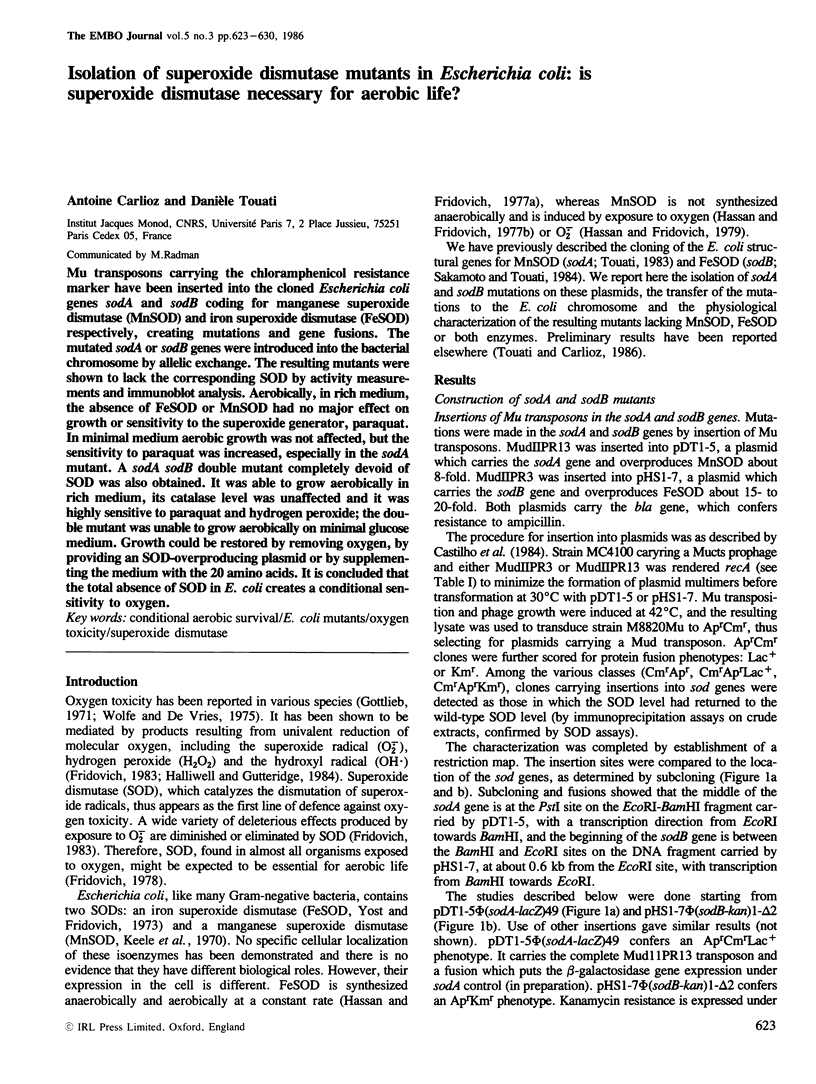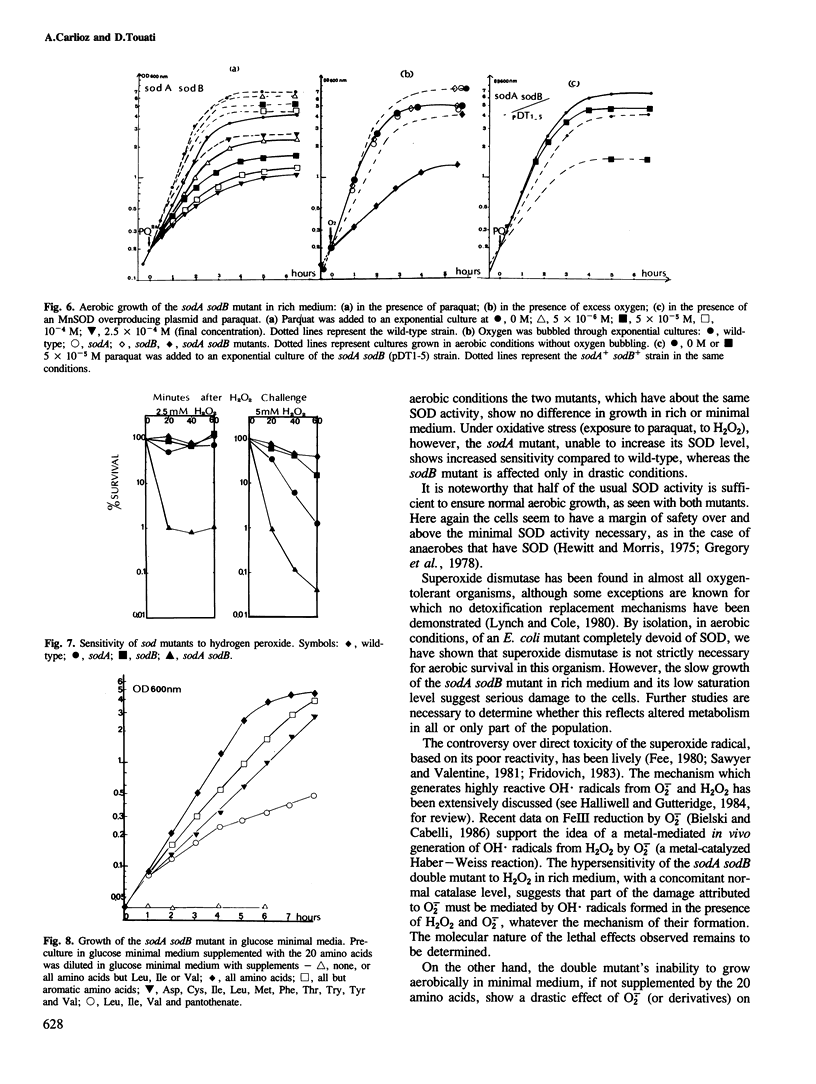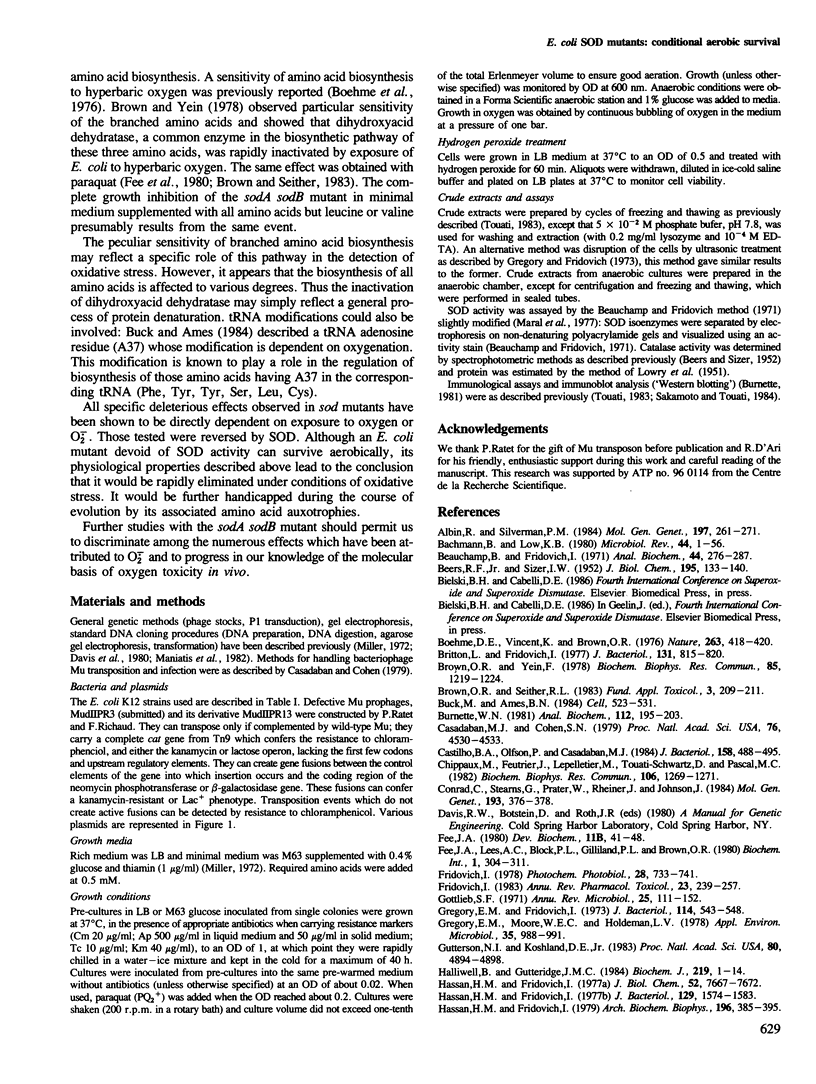Abstract
Mu transposons carrying the chloramphenicol resistance marker have been inserted into the cloned Escherichia coli genes sodA and sodB coding for manganese superoxide dismutase (MnSOD) and iron superoxide dismutase (FeSOD) respectively, creating mutations and gene fusions. The mutated sodA or sodB genes were introduced into the bacterial chromosome by allelic exchange. The resulting mutants were shown to lack the corresponding SOD by activity measurements and immunoblot analysis. Aerobically, in rich medium, the absence of FeSOD or MnSOD had no major effect on growth or sensitivity to the superoxide generator, paraquat. In minimal medium aerobic growth was not affected, but the sensitivity to paraquat was increased, especially in the sodA mutant. A sodA sodB double mutant completely devoid of SOD was also obtained. It was able to grow aerobically in rich medium, its catalase level was unaffected and it was highly sensitive to paraquat and hydrogen peroxide; the double mutant was unable to grow aerobically on minimal glucose medium. Growth could be restored by removing oxygen, by providing an SOD-overproducing plasmid or by supplementing the medium with the 20 amino acids. It is concluded that the total absence of SOD in E. coli creates a conditional sensitivity to oxygen.
Full text
PDF







Images in this article
Selected References
These references are in PubMed. This may not be the complete list of references from this article.
- Albin R., Silverman P. M. Physical and genetic structure of the glpK-cpxA interval of the Escherichia coli K-12 chromosome. Mol Gen Genet. 1984;197(2):261–271. doi: 10.1007/BF00330972. [DOI] [PubMed] [Google Scholar]
- BEERS R. F., Jr, SIZER I. W. A spectrophotometric method for measuring the breakdown of hydrogen peroxide by catalase. J Biol Chem. 1952 Mar;195(1):133–140. [PubMed] [Google Scholar]
- Bachmann B. J., Low K. B. Linkage map of Escherichia coli K-12, edition 6. Microbiol Rev. 1980 Mar;44(1):1–56. doi: 10.1128/mr.44.1.1-56.1980. [DOI] [PMC free article] [PubMed] [Google Scholar]
- Beauchamp C., Fridovich I. Superoxide dismutase: improved assays and an assay applicable to acrylamide gels. Anal Biochem. 1971 Nov;44(1):276–287. doi: 10.1016/0003-2697(71)90370-8. [DOI] [PubMed] [Google Scholar]
- Boehm D. E., Vincent K., Brown O. R. Oxygen and toxicity inhibition of amino acid biosynthesis. Nature. 1976 Jul 29;262(5567):418–420. doi: 10.1038/262418a0. [DOI] [PubMed] [Google Scholar]
- Britton L., Fridovich I. Intracellular localization of the superoxide dismutases of Escherichia coli: a reevaluation. J Bacteriol. 1977 Sep;131(3):815–820. doi: 10.1128/jb.131.3.815-820.1977. [DOI] [PMC free article] [PubMed] [Google Scholar]
- Brown O. R., Seither R. L. Oxygen and redox-active drugs: shared toxicity sites. Fundam Appl Toxicol. 1983 Jul-Aug;3(4):209–214. doi: 10.1016/s0272-0590(83)80127-4. [DOI] [PubMed] [Google Scholar]
- Brown O. R., Yein F. Dihydroxyacid dehydratase: the site of hyperbaric oxygen poisoning in branch-chain amino acid biosynthesis. Biochem Biophys Res Commun. 1978 Dec 14;85(3):1219–1224. doi: 10.1016/0006-291x(78)90672-1. [DOI] [PubMed] [Google Scholar]
- Buck M., Ames B. N. A modified nucleotide in tRNA as a possible regulator of aerobiosis: synthesis of cis-2-methyl-thioribosylzeatin in the tRNA of Salmonella. Cell. 1984 Feb;36(2):523–531. doi: 10.1016/0092-8674(84)90245-9. [DOI] [PubMed] [Google Scholar]
- Burnette W. N. "Western blotting": electrophoretic transfer of proteins from sodium dodecyl sulfate--polyacrylamide gels to unmodified nitrocellulose and radiographic detection with antibody and radioiodinated protein A. Anal Biochem. 1981 Apr;112(2):195–203. doi: 10.1016/0003-2697(81)90281-5. [DOI] [PubMed] [Google Scholar]
- Casadaban M. J., Cohen S. N. Lactose genes fused to exogenous promoters in one step using a Mu-lac bacteriophage: in vivo probe for transcriptional control sequences. Proc Natl Acad Sci U S A. 1979 Sep;76(9):4530–4533. doi: 10.1073/pnas.76.9.4530. [DOI] [PMC free article] [PubMed] [Google Scholar]
- Castilho B. A., Olfson P., Casadaban M. J. Plasmid insertion mutagenesis and lac gene fusion with mini-mu bacteriophage transposons. J Bacteriol. 1984 May;158(2):488–495. doi: 10.1128/jb.158.2.488-495.1984. [DOI] [PMC free article] [PubMed] [Google Scholar]
- Chippaux M., Feutrier J., Lepelletier M., Touati-Schwartz D., Pascal M. C. Selection of recA+ recombinant cosmids: an easy method for making recA strains temporarily Rec+, permitting P1-mediated transduction in a recA background and transduction of a recA mutation. Biochem Biophys Res Commun. 1982 Jun 30;106(4):1269–1271. doi: 10.1016/0006-291x(82)91249-9. [DOI] [PubMed] [Google Scholar]
- Conrad C. A., Stearns G. W., 3rd, Prater W. E., Rheiner J. A., Johnson J. R. Characterization of a glpK transducing phage. Mol Gen Genet. 1984;193(2):376–378. doi: 10.1007/BF00330696. [DOI] [PubMed] [Google Scholar]
- Fridovich I. Superoxide radical: an endogenous toxicant. Annu Rev Pharmacol Toxicol. 1983;23:239–257. doi: 10.1146/annurev.pa.23.040183.001323. [DOI] [PubMed] [Google Scholar]
- Fridovich I. Superoxide radicals, superoxide dismutases and the aerobic lifestyle. Photochem Photobiol. 1978 Oct-Nov;28(4-5):733–741. doi: 10.1111/j.1751-1097.1978.tb07009.x. [DOI] [PubMed] [Google Scholar]
- Gottlieb S. F. Effect of hyperbaric oxygen on microorganisms. Annu Rev Microbiol. 1971;25:111–152. doi: 10.1146/annurev.mi.25.100171.000551. [DOI] [PubMed] [Google Scholar]
- Gregory E. M., Fridovich I. Induction of superoxide dismutase by molecular oxygen. J Bacteriol. 1973 May;114(2):543–548. doi: 10.1128/jb.114.2.543-548.1973. [DOI] [PMC free article] [PubMed] [Google Scholar]
- Gregory E. M., Moore W. E., Holdeman L. V. Superoxide dismutase in anaerobes: survey. Appl Environ Microbiol. 1978 May;35(5):988–991. doi: 10.1128/aem.35.5.988-991.1978. [DOI] [PMC free article] [PubMed] [Google Scholar]
- Gutterson N. I., Koshland D. E., Jr Replacement and amplification of bacterial genes with sequences altered in vitro. Proc Natl Acad Sci U S A. 1983 Aug;80(16):4894–4898. doi: 10.1073/pnas.80.16.4894. [DOI] [PMC free article] [PubMed] [Google Scholar]
- Halliwell B., Gutteridge J. M. Oxygen toxicity, oxygen radicals, transition metals and disease. Biochem J. 1984 Apr 1;219(1):1–14. doi: 10.1042/bj2190001. [DOI] [PMC free article] [PubMed] [Google Scholar]
- Hassan H. M., Fridovich I. Enzymatic defenses against the toxicity of oxygen and of streptonigrin in Escherichia coli. J Bacteriol. 1977 Mar;129(3):1574–1583. doi: 10.1128/jb.129.3.1574-1583.1977. [DOI] [PMC free article] [PubMed] [Google Scholar]
- Hassan H. M., Fridovich I. Intracellular production of superoxide radical and of hydrogen peroxide by redox active compounds. Arch Biochem Biophys. 1979 Sep;196(2):385–395. doi: 10.1016/0003-9861(79)90289-3. [DOI] [PubMed] [Google Scholar]
- Hassan H. M., Fridovich I. Regulation of the synthesis of superoxide dismutase in Escherichia coli. Induction by methyl viologen. J Biol Chem. 1977 Nov 10;252(21):7667–7672. [PubMed] [Google Scholar]
- Hewitt J., Morris J. G. Superoxide dismutase in some obligately anaerobic bacteria. FEBS Lett. 1975 Feb 15;50(3):315–318. doi: 10.1016/0014-5793(75)80518-7. [DOI] [PubMed] [Google Scholar]
- Keele B. B., Jr, McCord J. M., Fridovich I. Superoxide dismutase from escherichia coli B. A new manganese-containing enzyme. J Biol Chem. 1970 Nov 25;245(22):6176–6181. [PubMed] [Google Scholar]
- LOWRY O. H., ROSEBROUGH N. J., FARR A. L., RANDALL R. J. Protein measurement with the Folin phenol reagent. J Biol Chem. 1951 Nov;193(1):265–275. [PubMed] [Google Scholar]
- Lynch R. E., Cole B. C. Mycoplasma pneumoniae: a prokaryote which consumes oxygen and generates superoxide but which lacks superoxide dismutase. Biochem Biophys Res Commun. 1980 Sep 16;96(1):98–105. doi: 10.1016/0006-291x(80)91186-9. [DOI] [PubMed] [Google Scholar]
- Maral J., Puget K., Michelson A. M. Comparative study of superoxide dismutase, catalase and glutathione peroxidase levels in erythrocytes of different animals. Biochem Biophys Res Commun. 1977 Aug 22;77(4):1525–1535. doi: 10.1016/s0006-291x(77)80151-4. [DOI] [PubMed] [Google Scholar]
- Nettleton C. J., Bull C., Baldwin T. O., Fee J. A. Isolation of the Escherichia coli iron superoxide dismutase gene: evidence that intracellular superoxide concentration does not regulate oxygen-dependent synthesis of the manganese superoxide dismutase. Proc Natl Acad Sci U S A. 1984 Aug;81(15):4970–4973. doi: 10.1073/pnas.81.15.4970. [DOI] [PMC free article] [PubMed] [Google Scholar]
- Sakamoto H., Touati D. Cloning of the iron superoxide dismutase gene (sodB) in Escherichia coli K-12. J Bacteriol. 1984 Jul;159(1):418–420. doi: 10.1128/jb.159.1.418-420.1984. [DOI] [PMC free article] [PubMed] [Google Scholar]
- Shimosaka M., Fukuda Y., Murata K., Kimura A. Application of hybrid plasmids carrying glycolysis genes to ATP production by Escherichia coli. J Bacteriol. 1982 Oct;152(1):98–103. doi: 10.1128/jb.152.1.98-103.1982. [DOI] [PMC free article] [PubMed] [Google Scholar]
- Touati D. Cloning and mapping of the manganese superoxide dismutase gene (sodA) of Escherichia coli K-12. J Bacteriol. 1983 Sep;155(3):1078–1087. doi: 10.1128/jb.155.3.1078-1087.1983. [DOI] [PMC free article] [PubMed] [Google Scholar]
- Wolfe W. G., DeVries W. C. Oxygen toxicity. Annu Rev Med. 1975;26:203–217. doi: 10.1146/annurev.me.26.020175.001223. [DOI] [PubMed] [Google Scholar]
- Yost F. J., Jr, Fridovich I. An iron-containing superoxide dismutase from Escherichia coli. J Biol Chem. 1973 Jul 25;248(14):4905–4908. [PubMed] [Google Scholar]




